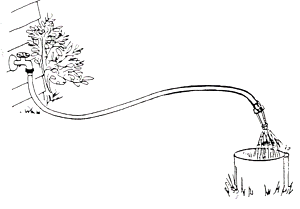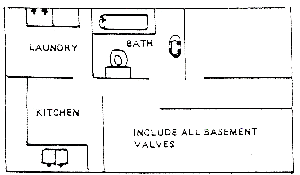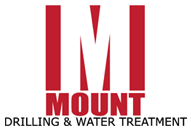Chlorinating A Well
Some things you should know before you chlorinate:
Chlorination will dislodge debris! In extreme cases well pumps and/or plumbing can become plugged up!
Do not be alarmed – this is to be expected. Because of the debris and discoloration, you may want to remove the aerator screens on spigots, due to them plugging up. In extreme iron and other debris conditions, the plumbing can become plugged, and a plumber may be needed. If you suspect these debris conditions, you should chlorinate the well system only first. This is done by shutting the main valves to the house and running chlorine and debris out of the pressure tank hose spigot. Then, re-chlorinate and run the chlorine throughout all the plumbing. This ensures that most debris is gone after the first chlorination and shouldn’t be too heavy the second time around.
Sometimes, it may be necessary to chlorinate and test the water more than once.
This is not unusual, especially on older wells and systems. Do not be alarmed if a test comes back positive (meaning bacteria is present). Simply re-chlorinate and try again.
The Health Department or independent lab will usually show two test results.
One is for E-Coli bacteria and one is for Coliform bacteria. E-Coli is more dangerous, and can cause health problems. Coliform is more prevalent in everyday life.
In some rare occasions, a well and system may not pass bacteria tests after repeated chlorination.
In this instance, a U-V light or permanent chlorination system may be needed.
How to Disinfect/Clorinate A Water Well:
 Remove the well cap or the vent pipe or plug if the well is equipped with a sanitary well seal.
Remove the well cap or the vent pipe or plug if the well is equipped with a sanitary well seal.
Pour 2 gallons of household bleach and 4 gallons* of white vinegar into the well (vinegar lowers the PH level in water and makes the chlorine much deadlier to bacteria). In deeper wells over 150′, more bleach and vinegar may be needed, but make sure to keep a 1 to 2 ratio. Also, make sure that straight bleach is used (no detergents or scents, etc.)
*please note: Bleach now comes in 3/4 gallon containers and it is much stronger than the old 1 gallon units and requires much more vinegar to lower the P.H.
 Connect a hose to a house spigot and run water directly into the well until chlorine odor is present in the water. Run the water this way for 15 minutes. The water will probably become discolored. This is normal.
Connect a hose to a house spigot and run water directly into the well until chlorine odor is present in the water. Run the water this way for 15 minutes. The water will probably become discolored. This is normal.
Shut off water supply to hose and proceed to systematically open each water fixture in the house one or two at a time. Let water run through each fixture until chlorine odor is present. Include both cold and hot water valves. It is essential that chlorine is present throughout the entire plumbing! Bacteria can and will back track through a pipe that has not been purified and cause tests to fail.
Close all valves and pour another one gallon of bleach directly into the well. Recap the well or replace the vent pipe or plug. Leave all valves closed for a period of 12 hours or longer (toilets may be flushed if needed.)
 Open the hose spigot and discharge water to ground surface of drainage ditch until chlorine odor disappears. Then shut hose off and one at a time open every household fixture and let water run until the chlorine odor is gone.
Open the hose spigot and discharge water to ground surface of drainage ditch until chlorine odor disappears. Then shut hose off and one at a time open every household fixture and let water run until the chlorine odor is gone.
The well should now be properly disinfected. Request your local Health Department to collect a sample of your water before drinking, every other use is fine. The phone number will usually be found listed under the city or county government offices in the white pages of your telephone directory.
Ready to talk to a water well specialist?
Mount Water Well Drilling
Please note: Please allow us at least 24 hours to respond to your email inquiry.
Email may not be used to cancel service.
Any cancellations MUST be done over the phone.
Water Well Service Areas in Ohio:
Licking County – Newark, Heath, Granville, Johnstown, New Albany, Hebron, Buckeye Lake, Thornville, Pataskala, Reynoldsburg, Utica, Hanover, Gratiot, Hartford, St. Louisville, Kirkersville, Alexandria.
Franklin County – Columbus, Bexley, Canal Winchester, Dublin, Gahanna, Grandview Heights, Grove City, Hilliard, New Albany, Pickerington, Reynoldsburg, Upper Arlington, Westerville, Whitehall, Worthington, Groveport, Obetz. (740) 527-4025
Fairfield County – Lancaster, Amanda, Baltimore, Bremen, Buckeye Lake, Canal Winchester, Carroll, Lithopolis, Millersport, Pleasantville, Rushville, Stoutsville, Sugar Grove, Tarlton, Thurston, West Rushville.
Hocking County – Logan, Buchtel, Laurelville, Murray City.
Muskingum County – Zanesville, Adamsville, Dresden, Frazeysburg, Fultonham, Gratiot, New Concord, Norwich, Philo, Roseville, South Zanesville.
Knox County – Mount Vernon, Centerburg, Danville, Fredericktown, Gambier, Gann, Martinsburg, Utica.
